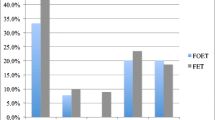Abstract
Purpose
To explore outcomes of donor In Vitro Fertilization (IVF) cycles with regards to cryopreservation and utilization of extra embryos after fresh transfer.
Methods
A database search was performed to identify all consecutive fresh donor oocyte cycles from January 1, 2000 to December 31, 2010 at a private fertility laboratory. Parameters analyzed included: number of oocytes retrieved, number of patients choosing embryo cryopreservation, number of patients returning for frozen embryo transfer (FET), and pregnancy outcomes.
Results
A total of 1070 fresh oocyte donor cycles were identified. Average number of oocytes retrieved was 16.9 ± 7.9, and average number of embryos transferred was 2.3 ± 0.96. Sixty-six percent of patients cryopreserved excess embryos following fresh transfer, and only 40 % of these patients ultimately returned for FET. Patients who conceived in their fresh cycle were much less likely to return for FET than those who did not (25 % v 65 %, p < 0.001), however chance of conceiving with FET was no different between these two groups (38 % v 38 %, NS).
Conclusions
An unexpectedly low number of patients undergoing a donor oocyte IVF cycle will ultimately return to utilize extra embryos from their fresh cycle. This is concerning considering the high numbers of oocytes retrieved and the known complications from hyperstimulation, especially in light of the relatively high pregnancy rates associated with donor cycles. This raises concerns not only for donor management, but also raises ethical dilemmas when considering the large numbers of remaining embryos that will never be utilized.

Similar content being viewed by others
References
Maxwell K, Cholst I, Rosenwaks Z. The incidence of both serious and minor complications in young women undergoing oocyte donation. Fertil Steril. 2008;90:2165–71.
Gardner D, Lane M, Stevens J, Schoolcraft W. Changing the start temperature and cooling rate in a slow-freezing protocol increases human blastocyst viability. Fertil Steril. 2003;79:407–10.
Kuwayama M, Vajta G, Kato O, Leibo SP. Highly efficient vitrification method for cryopreservation of human oocytes. Reprod Biomed Online. 2005;11:300–8.
Practice Committee of the American Society for Reproductive Medicine. Repetitive oocyte donation. Fertil Steril. 2008;90:S194–5.
Knopman JM, Talebian S, Berkeley AS, Grifo JA, Noyes N, Licciardi F. Fate of cryopreserved donor embryos. Fertil Steril. 2010;94:1689–92.
Mohler-Kuo M, Zellweger U, Duran A, Hohl MK, Gutzwiller F, Mutsch M. Attitudes of couples towards the destination of surplus embryos: results among couples with cryopreserved embryos in Switzerland. Hum Reprod. 2009;24:1930–8.
Bangsboll S, Pinborg A, Yding Anderson C, Nyboe AA. Patient’s attitudes towards donation of surplus cryopreserved embryos for treatment or research. Hum Reprod. 2004;19:2415–9.
Lazendorf S, Ratts V, Keller S, Odem R. Disposition of the cryopreserved embryos by infertility patients desiring to discontinue storage. Fertil Steril. 2010;93:486–9.
Author information
Authors and Affiliations
Corresponding author
Additional information
Capsule
Few patients undergoing donor oocyte IVF ultimately return to utilize their excess embryos causing concern for aggressive donor stimulation considering large numbers of unused embryos.
Rights and permissions
About this article
Cite this article
Cook, H., Briton-Jones, C. & Hill, D. Low utilization of extra embryos in donor oocyte in vitro fertilization cycles: an ethical dilemma to donor management. J Assist Reprod Genet 30, 1031–1034 (2013). https://doi.org/10.1007/s10815-013-0038-6
Received:
Accepted:
Published:
Issue Date:
DOI: https://doi.org/10.1007/s10815-013-0038-6




